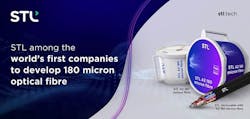STL offers microcables with 180-micron optical fiber
STL (NSE: STLTECH) has used this week’s FTTH Conference in Madrid, Spain, to unveil its new 180-micron optical fiber. The company displayed a 288-fiber microcable in its booth at the show that can be deployed in 8-mm ducts.
The 180-micron G657 A2 fiber offers both bend insensitivity and backwards compatibility to ease deployment. The company asserts the slimmer fiber will enable network operators to deploy more fiber in limited duct space, which will reduce costs and deployment times.
“If it's a problem for the end customers, operators, or installers - it's a problem worth solving for us,” commented Jitendra Balakrishnan, CTO-Optical Networking at STL, regarding the need for such microcable. “We need to make extremely smart use of the limited duct space in high- and medium-density areas, for rollouts to be fast and cost-effective. Our product is going to deliver just that.”
“The amount of fiber the world needs is immense. R&D and innovation in fiber design will be, according to us, the most important driver for future-ready networks,” added Paul Atkinson, CEO-Optical Networking at STL. “We are intensely focused on product innovations that will enable fiberization in a scalable, faster, and cost-effective way. STL’s high-density microcable and integrated optical connectivity offerings will deliver a lot of value for our customers. I am also very excited about the fact that it will significantly reduce the plastic in the ground and contribute to our customer’s sustainability goals.”
For related articles, visit the FTTx Topic Center.
For more information on fiber cabling technology and suppliers, visit the Lightwave Buyer’s Guide.
To stay abreast of fiber network deployments, subscribe to Lightwave’s Service Providers and Datacom/Data Center newsletters.

Stephen Hardy | Editorial Director and Associate Publisher, Lightwave
Stephen Hardy is editorial director and associate publisher of Lightwave and Broadband Technology Report, part of the Lighting & Technology Group at Endeavor Business Media. Stephen is responsible for establishing and executing editorial strategy across the both brands’ websites, email newsletters, events, and other information products. He has covered the fiber-optics space for more than 20 years, and communications and technology for more than 35 years. During his tenure, Lightwave has received awards from Folio: and the American Society of Business Press Editors (ASBPE) for editorial excellence. Prior to joining Lightwave in 1997, Stephen worked for Telecommunications magazine and the Journal of Electronic Defense.
Stephen has moderated panels at numerous events, including the Optica Executive Forum, ECOC, and SCTE Cable-Tec Expo. He also is program director for the Lightwave Innovation Reviews and the Diamond Technology Reviews.
He has written numerous articles in all aspects of optical communications and fiber-optic networks, including fiber to the home (FTTH), PON, optical components, DWDM, fiber cables, packet optical transport, optical transceivers, lasers, fiber optic testing, and more.
You can connect with Stephen on LinkedIn as well as Twitter.
